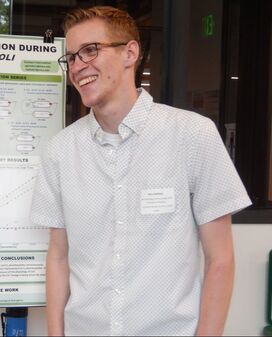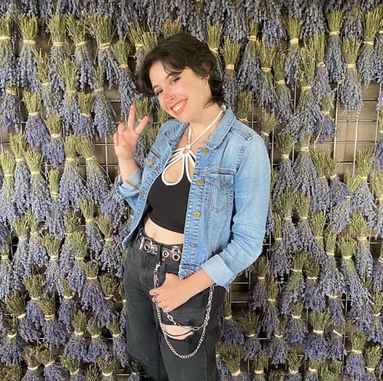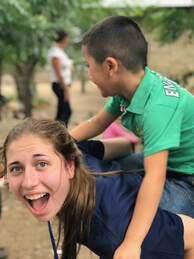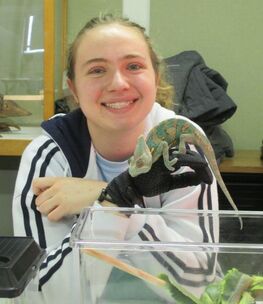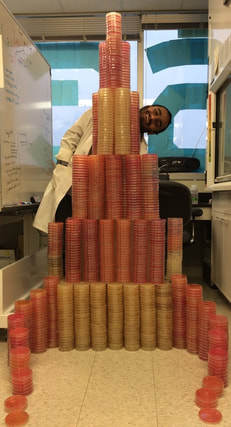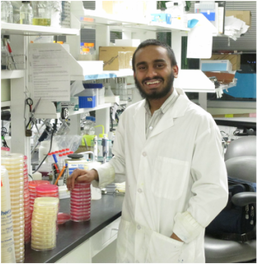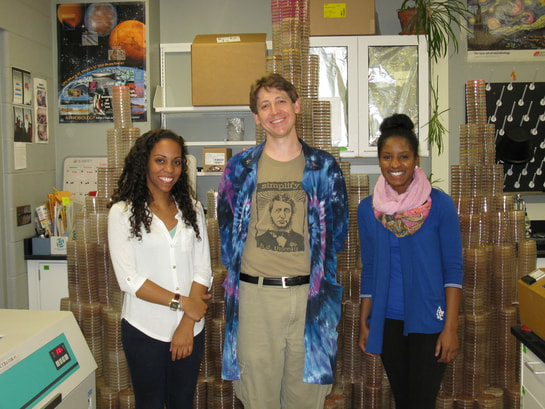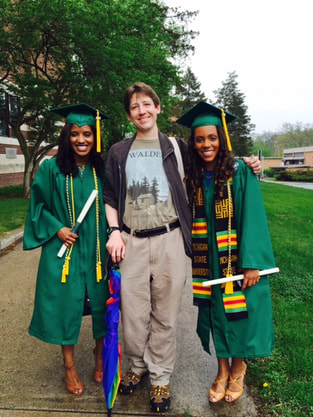I am fortunate to work with and mentor gifted and hardworking undergraduates. They not only help to advance the research I do, but also to add to the satisfaction I gain as a scientist. Moreover, I have found that my mentees teach me as much, if not more, than I teach them. If you are interested in working with me, please get in touch!
Mentorship Philosophy
I view mentorship as a matter of helping a research student become a colleague. As in my classroom teaching, I focus on developing a supportive, safe, egalitarian relationship with my mentees that is oriented around valuing them first and foremost human beings. To ensure clarity in the relationship, I develop compacts with my mentees that define our responsibilities and expectations toward each other. When initiating a mentorship, I talk with the mentee to assess where they are in their experience and knowledge, which allows me to tailor their initial training to their needs, regardless of whether they are an undergraduate or graduate student. I typically start students off slowly, working with them to help them to develop their basic lab skills and familiarizing them with essential protocols. After a student is up to speed, I have them begin work on parts of an existing project. Along the way, I teach them the basics of scientific thinking, including discussion of Platt’s classic “Strong Inference” paper, as well as lessons drawn from the BEACON Center’s Scientific Virtues Project, which has been led by philosopher Robert Pennock. Once a student has gotten enough experience, I work with them to develop a project of their own that is commensurate with their interests and rank. From there, the focus is on troubleshooting, creativity, critical thinking, and the development of writing and presentation skills.
Mentorship Philosophy
I view mentorship as a matter of helping a research student become a colleague. As in my classroom teaching, I focus on developing a supportive, safe, egalitarian relationship with my mentees that is oriented around valuing them first and foremost human beings. To ensure clarity in the relationship, I develop compacts with my mentees that define our responsibilities and expectations toward each other. When initiating a mentorship, I talk with the mentee to assess where they are in their experience and knowledge, which allows me to tailor their initial training to their needs, regardless of whether they are an undergraduate or graduate student. I typically start students off slowly, working with them to help them to develop their basic lab skills and familiarizing them with essential protocols. After a student is up to speed, I have them begin work on parts of an existing project. Along the way, I teach them the basics of scientific thinking, including discussion of Platt’s classic “Strong Inference” paper, as well as lessons drawn from the BEACON Center’s Scientific Virtues Project, which has been led by philosopher Robert Pennock. Once a student has gotten enough experience, I work with them to develop a project of their own that is commensurate with their interests and rank. From there, the focus is on troubleshooting, creativity, critical thinking, and the development of writing and presentation skills.
Current Students
|
Max Halliday
Microbiology and Molecular Genetics, Class of 2024 March 2023 - Present Max has been working on a project that examines how the fitness of the Cit+ lineage on different resources has changed over time as it has been undergoing ecological divergence and incipient speciation. As he transitions to the MMG BS-MS program, he will begin to work with Dr. Kyle Card, a former Lenski-ite who is now at the Cleveland Clinic, on a project that will study how population size, niche, and mutation rate affect the potential to evolve antibiotic resistance in E. coli. He's also an excellent swimmer and may, in fact, be Aquaman. |
|
|
Claire "Spends" Spender
Microbiology and Molecular Genetics, Class of 2024 May 2023 - Present Like Max, Spends has been working on a project that examines how the fitness of the Cit+ lineage has changed on different resources over time as it has ecological diverged from its ancestor and undergone incipient speciation. In the future, they will be working on a project that will identify the niche-specific adaptive mutations (NSAMs) that have caused simultaneous loss of fitness on glucose and gain of fitness on citrate and C4-dicarboxylates in the Cit+ lineage owing to antagonistic pleiotropy, thus playing an important role in the incipient speciation we are seeing. They also have an interest in biowarfare and may, strictly speaking, be too cool to be working with a square like me. (Thankfully, they are tolerant.) |
Past Students
Maximo Clark
September 2021 - March 2023
Maximo oversaw a project in which he used experimental evolution to examine how the potential of the Cit+ lineage to re-adapt to growth on glucose changed as it has diverged ecologically, losing fitness on its ancestral glucose resource and gaining fitness on its new citrate and C4-dicarboxylate resources. He also worked to isolate variants and constructs needed for work designed to establish how the Cit+ lineage's fitness has changed on different resources during ecological divergence and incipient speciation.
September 2021 - March 2023
Maximo oversaw a project in which he used experimental evolution to examine how the potential of the Cit+ lineage to re-adapt to growth on glucose changed as it has diverged ecologically, losing fitness on its ancestral glucose resource and gaining fitness on its new citrate and C4-dicarboxylate resources. He also worked to isolate variants and constructs needed for work designed to establish how the Cit+ lineage's fitness has changed on different resources during ecological divergence and incipient speciation.
|
|
Jessica Baxter
Human Biology, Class of 2020. May 2018 - June 2020 Jessica was a Jill-of-all-projects, working on completing odds and ends of the projects that her predecessors had to leave behind when they moved on. She mainly worked on engineering the Cit+ trait into Cit- genetic backgrounds from other LTEE populations, a project that was begun by Maia Rowles. She has since moved on to medical school and a promising career as an outstanding physician. Brooke Sommerfeld Zoology, class of 2018. September 2015 - July 2018. Brooke worked on a project that is looking at a lineage of Cit- clones that persisted in the Ara-3 population for more than 10,000 generations after Cit+ became numerically dominant. How did this lineage survive when Cit- was outnumbered up to 100 to one? Part of the explanation is that Cit- evolved to use byproducts, C4-dicarboxylates, excreted into the medium by Cit+ during growth on citrate. Brooke examined how important access to these C4-dicarboxylates is by eliminating the ability to use them in Cit- clones from a time series from 33,000 through 43,000 generations. Brooke also worked on a project in which she looked at the evolution of Cit- specialists in populations founded with Cit+ clones and evolved in a citrate-only resource environment. Brooke is currently a Veterinary Assistant at Animal Samaritans in Thousand Oaks, California. Tanush Jagdish November 2015 - June 2017 Tanush worked on a project aimed at determining what genes are required for the expression of the Cit+ trait. The evolution of novel traits like Cit+ are contingent upon the existence of a genetic background in which it can arise. This means in part that the expression of a new trait generally depends on the activity of pre-existing genes. This may be seen as both a form of potentiation and deep contingency, as well as a reflection of how evolution builds new structures and traits from and upon the old ones. Tanush sought to identify the genes required for the Cit+ trait by screening a library of mutant E. coli, the Keio Collection, each member of which has an insertion disrupting a different gene. This screen involved transforming each mutant with a plasmid that normally confers the Cit+ trait. If a transformant does not show the Cit+ trait, then the gene that is deleted in that transformant is putatively necessary for aerobic growth on citrate. Tanush also picked up some of my artistic interests, it seems... Tanush earned a PhD from Harvard University in 2023, where he worked with Michael Desai and Andrew Murray. He is currently an associate at McKinsey and Company. Maia Rowles 2012 - 2015 Previous work (Blount et al 2008) has shown that the evolution of citrate usage in the Ara-3 LTEE population was contingent upon the construction of a potentiating genetic background that improved the rate of mutation to Cit+, likely due to metabolic pre-adaptation that made a final mutation effective in generating the Cit+ trait. Maia's research involved investigating whether or not potentiating genetic backgrounds have evolved in the other 11 LTEE populations. She presented her preliminary data at the 2015 ASM General Meeting in New Orleans. Maia went on to obtain an MS in Cancer Chemical Biology from the University of Michigan. She is currently aiming for medical school while working at Waters Technology Corporation. Kiyana Weatherspoon 2012 - 2015 Kiyana's research involved investigating aspects of specialization in the Cit+ lineage in Ara-3, a question that has implications for understanding the ecology of the population, as well as whether or not Cit+ is a new species in the making. She presented her preliminary data at the 2015 ASM General Meeting in New Orleans. Kiyana obtained a MS in Biomedical Engineering from George Washington University, and currently works at the FDA as a Biomedical Engineering Reviewer. |
